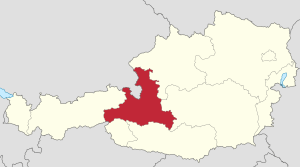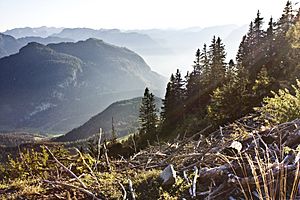Salzburg (state) facts for kids
Quick facts for kids
Salzburg
|
|||
|---|---|---|---|
|
|||
 |
|||
| Country | |||
| Capital | Salzburg | ||
| Area | |||
| • Total | 7,156.03 km2 (2,762.96 sq mi) | ||
| Population | |||
| • Total | 531,800 | ||
| • Density | 74.315/km2 (192.475/sq mi) | ||
| Time zone | UTC+1 (CET) | ||
| • Summer (DST) | UTC+2 (CEST) | ||
| ISO 3166 code | AT-5 | ||
| HDI (2017) | 0.928 very high · 2nd |
||
| NUTS Region | AT3 | ||
| Votes in Bundesrat | 4 (of 62) | ||
| Website | www.salzburg.gv.at | ||
Salzburg is a beautiful state in Austria. It's officially called Land Salzburg, but many people also call it Salzburgerland. This helps tell it apart from its capital city, also named Salzburg. It's special because it's the only state named after its main city! For hundreds of years, Salzburg was ruled by a Prince-Bishop. This was like a religious leader and a ruler all in one. This long history makes Salzburg's traditions different from other parts of Austria.
Contents
Exploring Salzburg's Geography
Salzburg state stretches along its main river, the Salzach. This river flows from the Central Eastern Alps in the south, where the mountain Großvenediger reaches 3,657 meters (11,998 feet) high. It then goes down into the Alpine foothills in the north. The state covers an area of about 7,156 square kilometers (2,763 square miles).
Where is Salzburg Located?
Salzburg is in the north of Austria. It is very close to the border with the German state of Bavaria. Other Austrian states surround it. These include Upper Austria to the northeast and Styria to the east. To the south, you'll find Carinthia. To the southwest are Tyrol, South Tyrol (in Italy), and East Tyrol. With about 529,085 people, Salzburg is one of Austria's smaller states by population.
Mountains and Landscapes
In the south of Salzburg, you'll find the main ranges of the Alpine mountains. These include the Hohe Tauern mountains, which have many peaks over 3,000 meters (9,800 feet) high. The Dachstein mountains and the Berchtesgaden Alps are part of the Northern Limestone Alps. They form the borders of Salzburg Land to the east and north.
Salzburg's Five Main Regions
The state is divided into five main areas. These are called Gaue and match its political districts, known as Bezirk.
- Northern Part:
- Flachgau: This area includes Salzburg city and its surroundings. Flach means flat in German, and this area is a flat basin where the Salzach and Saalach rivers meet. It stretches from the Salzkammergut Mountains to the Untersberg mountains.
- Tennengau: This district is named after the Tennen Mountains. It includes the wide Salzach Valley south of Salzburg and the nearby Limestone Alps.
- Southern Mountainous Part: (often called Innergebirg)
Major Cities and Towns
Here are some of the biggest cities and towns in Salzburg state:
 Salzburg city (population 148,521)
Salzburg city (population 148,521) Hallein (population 20,022)
Hallein (population 20,022) Saalfelden (population 16,046)
Saalfelden (population 16,046) Sankt Johann im Pongau (population 10,740)
Sankt Johann im Pongau (population 10,740) Bischofshofen (population 10,352)
Bischofshofen (population 10,352) Zell am See (population 9,683)
Zell am See (population 9,683) Seekirchen (population 9,945)
Seekirchen (population 9,945) Neumarkt am Wallersee (population 5,846)
Neumarkt am Wallersee (population 5,846) Oberndorf bei Salzburg (population 5,600)
Oberndorf bei Salzburg (population 5,600) Mittersill (population 5,443)
Mittersill (population 5,443) Radstadt (population 4,864)
Radstadt (population 4,864)
Wals-Siezenheim is a large community with about 12,000 people. It is known as 'Austria's largest village'.
A Look at Salzburg's History
Salt has always been very important to this region. In fact, the name Salzburg means "salt castle"!
Salzburg as an Independent State
Salzburg became independent from Bavaria in the late 1300s. For a long time, the Archbishopric of Salzburg was an independent state within the Holy Roman Empire. It was ruled by a Prince-Bishop. This independence lasted until 1803.
Changes in Rule
In 1803, Salzburg became the Electorate of Salzburg. It was given to Ferdinand III, who was the former Grand Duke of Tuscany. He was also the brother of Emperor Francis II.
The End of Independence
After Austria lost the Battle of Austerlitz in 1805, Salzburg became part of Austria. This was to make up for Austria losing Tyrol to the Kingdom of Bavaria. Ferdinand was then moved to rule the Grand Duchy of Würzburg.
Part of Bavaria
Austria lost another war in 1809. Because of this, Salzburg was given to Bavaria in 1810.
Divided Between Two Countries
In 1816, after Napoleon was defeated, Salzburg was returned to Austria. However, a small part in the northwest, called Rupertiwinkel, stayed with Bavaria. The rest of Salzburg was managed as a department of Upper Austria. In 1849, the Duchy of Salzburg was created. It was a special region of the Austrian Empire and later Austria-Hungary.
World War I and Beyond
Salzburg was part of the Austro-Hungarian Empire during World War I. About 49,000 people from Salzburg joined the army, and 6,000 of them sadly died.
After World War I
In 1918, after World War I, the Duchy of Salzburg ended. It became the State of Salzburg. This state was first part of German Austria and then the First Republic of Austria. In November 1918, 99% of people in Salzburg voted to join Germany.
Salzburg in Germany
After a vote in 1938, Salzburg state and all of Austria became part of Nazi Germany.
Under American Control
After Nazi Germany was defeated in 1945, the Allies occupied Austria. Salzburg was controlled by the United States.
Salzburg as an Austrian State Again
In 1955, Austria became independent from the Allies once more. Salzburg was again one of the federal states of the new Republic of Austria.
Other pages
Images for kids
See also
 In Spanish: Salzburgo (estado) para niños
In Spanish: Salzburgo (estado) para niños






